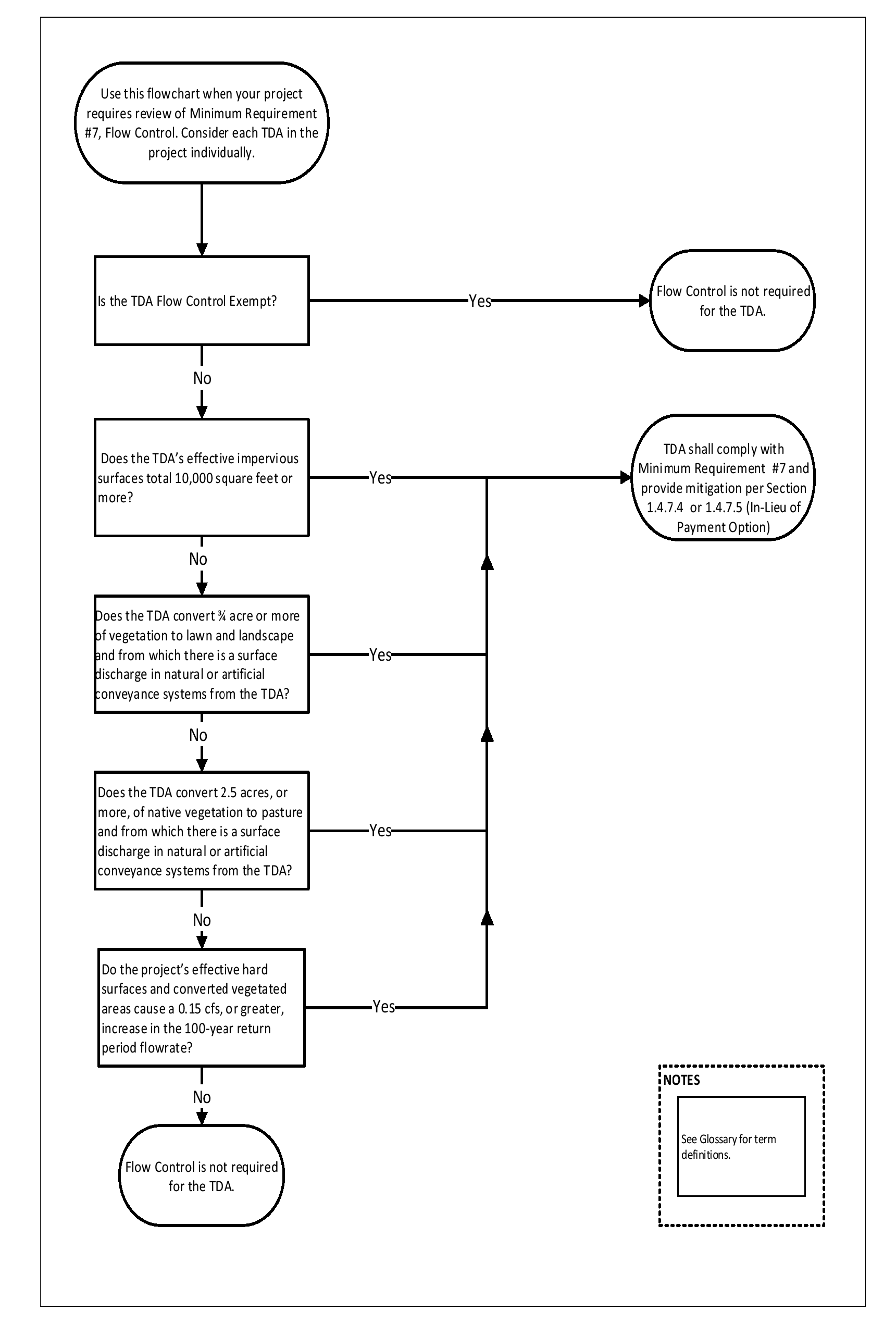1.4.7 Minimum Requirement 7 - Flow Control
1.4.7.1 Flow Control Applicability
Projects meeting or exceeding the flow control thresholds must provide flow control to reduce the impacts of stormwater from hard surfaces and land cover conversions. The applicability and type of flow control that may be required is based upon discharge location and project impacts.
When assessing a project against flow control thresholds, only consider those surfaces that are subject to this Minimum Requirement as determined in Applicability of the Minimum Requirements and Additional Protective Measures.
Per Joint Administrative Policy and Procedure Directive No. 2021-02-001, Environmental Services/Site Development Group reserves the right to make the determination that the flow control standards be applied to any project based upon known downstream erosion issues or potential erosion issues.
When Minimum Requirement #8 is also required, an attempt must be made to meet both Minimum Requirements. If it is not possible to meet both requirements, then the requirement to maintain the hydroperiod of the wetland (meeting Minimum Requirement #8) becomes the overriding concern and documentation must be provided detailing why both requirements could not be met.
1.4.7.2 Flow Control Exempt Threshold Discharge Areas
Flow Control is not required for Flow Control Exempt Threshold Discharge Areas.
1.4.7.3 Flow Control Thresholds
Threshold Discharge Areas (TDAs) that are not Flow Control Exempt TDAs within a project that meet or exceed any of the following thresholds shall provide Flow Control Mitigation.
Threshold Discharge Areas (TDAs) that have a total of 10,000 square feet or more of effective impervious surface, or
TDAs that convert ¾ acres or more of vegetation to lawn or landscaped area and from which there is a surface discharge in natural or artificial conveyance systems from the TDA, or
TDAs that convert 2.5 acres or more of native vegetation to pasture and from which there is a surface discharge in natural or artificial conveyance systems from the TDA, or
TDAs that, through a combination of effective hard surfaces and converted vegetation areas, cause a 0.15 cfs or greater increase in the 100-year return period flowrate as estimated using an approved continuous simulation model with 15 minute timesteps. Comparison shall be between existing and proposed project site land cover conditions.
Figure 1 - 6: Flow Control Flowchart can be used as a tool to help determine when flow control is required
Figure 1 - 6: Flow Control Flowchart
1.4.7.4 Flow Control Mitigation
Using an Ecology approved continuous simulation model for design, assuming 15-minute timesteps, stormwater discharges shall match developed discharge durations to predeveloped discharge durations for the range of predeveloped discharge rates from 50% of the 2-year return period flowrate up to the full 50-year return period flowrate. The predeveloped condition to be matched shall be a forested land cover condition (Flow Control - Forested Condition Mitigation) unless:
Reasonable historic information is provided that indicates the site was prairie prior to settlement.
Note: an applicant may submit this historical information as part of the Stormwater Site Plan Report for any given project.
In this case, the predeveloped condition to be matched can be modeled as pasture (Flow Control - Pasture Conditions Mitigation)
The project is located within an area which has been verified to have 40% Total Impervious Area as of 1985 (the drainage area of the immediate stream and all subsequent downstream basins have had at least 40% total impervious area (TIA) since 1985). Figure 1 - 4: 40% Total Impervious Area as of 1985 depicts those areas meeting the criteria. The City of Tacoma tMap also has a layer showing these areas.
Note: only the approved map determines these areas. Additionally areas cannot be added on a case by case basis.
In this case, the predeveloped condition to be matched can be the existing land cover condition (Flow Control - Existing Conditions Mitigation).
1.4.7.5 In-Lieu of Payment Option
In lieu of constructing flow control facilities, applicants may pay a fee to the City of Tacoma. The payment will offset construction of City owned and maintained regional stormwater facilities. In order to participate, the program must have capacity available and projects must meet certain eligibility requirements. The “Regional Stormwater Facilities Program” document available at https://www.cityoftacoma.org/stormwatermanual contains the program requirements, fees, and project feasibility criteria.
1.4.7.6 Flow Control Facility Selection, Design, and Maintenance
Flow control facilities shall be:
Selected in accordance with guidance in Volume 4;
Designed in accordance with criteria in Volume 4; and
Maintained in accordance with the maintenance standards in Volume 4.
The purpose of the flow control – requirement is to prevent increases in natural stream channel erosion rates. The standard intends to maintain the total amount of time that a receiving stream exceeds an erosion causing threshold based upon historic rainfall and natural land cover conditions. That threshold is assumed to be 50% of the 2-year return period flowrate. Maintaining the naturally occurring erosion rates within streams is vital, though by itself insufficient, to protect fish habitat and production.
